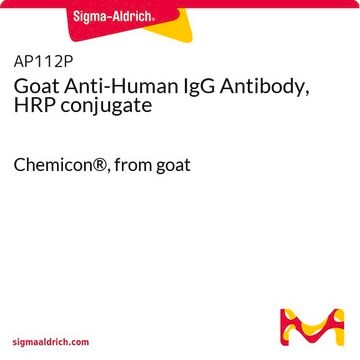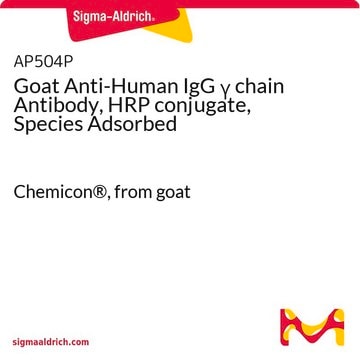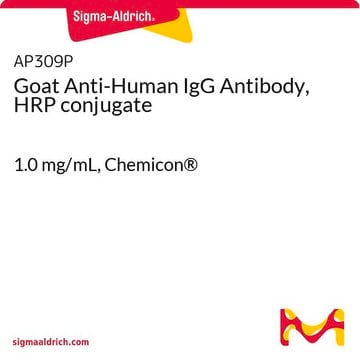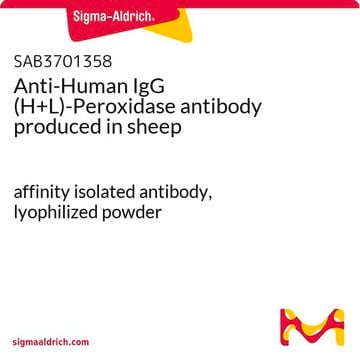A0170
Anti-Human IgG (Fc specific)−Peroxidase antibody produced in goat
affinity isolated antibody
Synonym(s):
Anti Human IgG Antibody - Anti-Human IgG (Fc specific)-Peroxidase antibody produced in goat, Anti Human Igg, Anti Human Igg Hrp, Anti-Human Igg
About This Item
Recommended Products
biological source
goat
conjugate
peroxidase conjugate
antibody form
affinity isolated antibody
antibody product type
secondary antibodies
clone
polyclonal
species reactivity
human
technique(s)
direct ELISA: 1:60,000
dot blot: 1:100,000 (chemiluminescent)
immunohistochemistry (formalin-fixed, paraffin-embedded sections): 1:200
shipped in
dry ice
storage temp.
−20°C
target post-translational modification
unmodified
General description
The antibody is isolated from anti-human IgG antiserum by immunospecific purification to remove essentially all goat serum proteins, including immunoglobulins, which do not specifically bind to the Fc fragment of human IgG. Anti-Human IgG is conjugated to peroxidase and is purified to remove unconjugated material.
Specificity and cross-reactivity of the Anti-Human IgG (Fc specific)-Peroxidase is determined by ELISA. The conjugate is specific for human IgG (Fc fragment) when tested against human IgA, IgG (Fab and Fc fragments), IgM, Bence Jones kappa, and lambda myeloma proteins. Furthermore, the conjugate shows no reactivity with mouse or rat IgG and yields reduced background with mouse or rat samples.
Specificity
Immunogen
Application
Enzyme-linked immunosorbent assay (12 papers)
Western Blotting (3 papers)
Biochem/physiol Actions
Physical form
Preparation Note
Storage and Stability
Disclaimer
Not finding the right product?
Try our Product Selector Tool.
Signal Word
Warning
Hazard Statements
Precautionary Statements
Hazard Classifications
Skin Sens. 1
Storage Class Code
12 - Non Combustible Liquids
WGK
WGK 2
Flash Point(F)
Not applicable
Flash Point(C)
Not applicable
Certificates of Analysis (COA)
Search for Certificates of Analysis (COA) by entering the products Lot/Batch Number. Lot and Batch Numbers can be found on a product’s label following the words ‘Lot’ or ‘Batch’.
Already Own This Product?
Find documentation for the products that you have recently purchased in the Document Library.
Customers Also Viewed
Articles
Review the key factors that should figure in your decision to choose a secondary antibody. Learn about species, subclass, isotype, label, and more.
Review the key factors that should figure in your decision to choose a secondary antibody. Learn about species, subclass, isotype, label, and more.
Review the key factors that should figure in your decision to choose a secondary antibody. Learn about species, subclass, isotype, label, and more.
Review the key factors that should figure in your decision to choose a secondary antibody. Learn about species, subclass, isotype, label, and more.
Protocols
Tips and troubleshooting for FFPE and frozen tissue immunohistochemistry (IHC) protocols using both brightfield analysis of chromogenic detection and fluorescent microscopy.
Tips and troubleshooting for FFPE and frozen tissue immunohistochemistry (IHC) protocols using both brightfield analysis of chromogenic detection and fluorescent microscopy.
Tips and troubleshooting for FFPE and frozen tissue immunohistochemistry (IHC) protocols using both brightfield analysis of chromogenic detection and fluorescent microscopy.
Tips and troubleshooting for FFPE and frozen tissue immunohistochemistry (IHC) protocols using both brightfield analysis of chromogenic detection and fluorescent microscopy.
Our team of scientists has experience in all areas of research including Life Science, Material Science, Chemical Synthesis, Chromatography, Analytical and many others.
Contact Technical Service

















